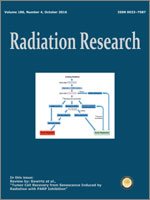There is little known about the effect of both reduced weight bearing and exposure to radiation during spaceflight on the mechanically-sensitive cartilage lining the knee joint. In this study, we characterized cartilage damage in rat knees after periods of reduced weight bearing with/without exposure to solar-flare-relevant radiation, then cartilage recovery after return to weight bearing. Male Sprague Dawley rats (n = 120) were either hindlimb unloaded (HLU) via tail suspension or remained weight bearing in cages (GROUND). On day 5, half of the HLU and GROUND rats were 1 Gy total-body X-ray irradiated during HLU, and half were sham irradiated (SHAM), yielding 4 groups: GROUND-SHAM; GROUND-IR; HLU-SHAM; and HLU-IR. Hindlimbs were collected from half of each group of rats on day 13. The remaining rats were then removed from HLU or remained weight bearing, and hindlimbs from these rats were collected on day 62. On day 13, glycosaminoglycan (GAG) content in cartilage lining the tibial plateau and femoral condyles of HLU rats was lower than that of the GROUND animals. Likewise, on day 13, immunoreactivity of the collagen type II-degrading matrix metalloproteinase-13 (MMP-13) and of a resultant metalloproteinase-generated neoepitope VDIPEN was increased in all groups versus GROUND-SHAM. Clustering of chondrocytes indicating cartilage damage was present in all HLU and IR groups versus GROUND-SHAM on day 13. On day 62, after 49 days of reloading, the loss of GAG content was attenuated in the HLU-SHAM and HLU-IR groups, and the increased VDIPEN staining in all treatment groups was attenuated. However, the increased chondrocyte clustering remained in all treatment groups on day 62. MMP-13 activity also remained elevated in the GROUND-IR and HLU-IR groups. Increased T2 relaxation times, measured on day 62 using 7T MRI, were greater in GROUND-IR and HLU-IR knees, indicating persistent cartilage damage in the irradiated groups. Both HLU and total-body irradiation resulted in acute degenerative and pre-arthritic changes in the knee articular cartilage of rats. A return to normal weight bearing resulted in some recovery from cartilage degradation. However, radiation delivered as both a single challenge and when combined with HLU resulted in chronic cartilage damage. These findings suggest that radiation exposure during spaceflight leads to and/or impairs recovery of cartilage upon return to reloading, generating long-term joint problems for astronauts.
How to translate text using browser tools
7 September 2016
Spaceflight-Relevant Challenges of Radiation and/or Reduced Weight Bearing Cause Arthritic Responses in Knee Articular Cartilage
J. S. Willey,
A. T. Kwok,
J. E. Moore,
V. Payne,
C. A. Lindburg,
S. A. Balk,
J. Olson,
P. J. Black,
M. C. Walb,
R. R. Yammani,
M. T. Munley
ACCESS THE FULL ARTICLE

Radiation Research
Vol. 186 • No. 4
October 2016
Vol. 186 • No. 4
October 2016




